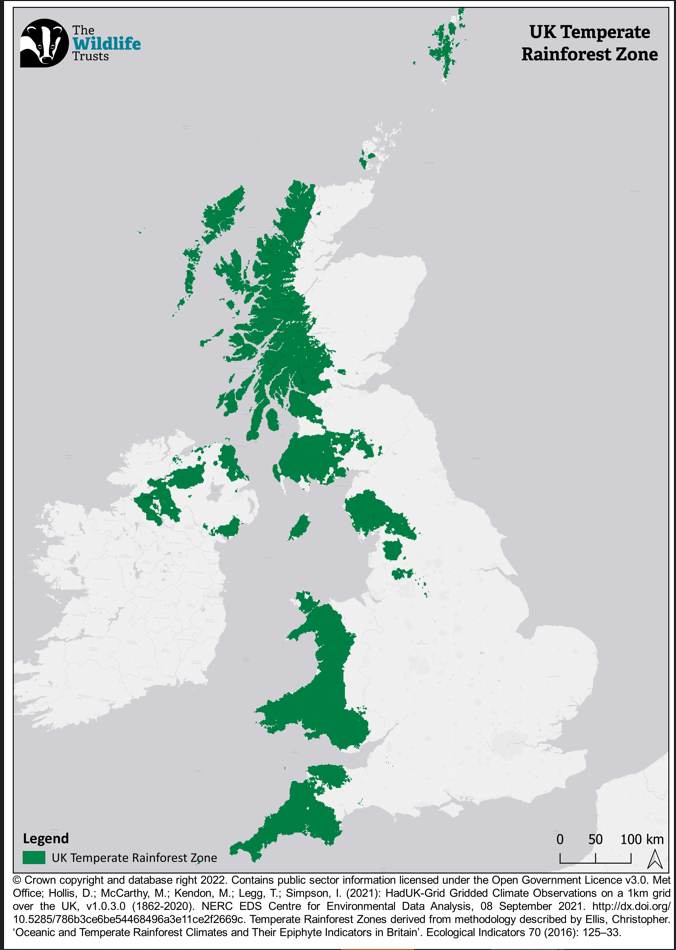First locations for The Wildlife Trusts’ Atlantic rainforest recovery programme announced

Isle of Man and North Wales are first to benefit from £38million Aviva fund
The Isle of Man and North Wales are the first places where The Wildlife Trusts will begin restoring and expanding rainforests across the British Isles, following a donation of £38 million from Aviva.
British rainforests have been largely destroyed over hundreds of years and now cover less than 1% of Britain. The restoration of this precious habitat is part of a wider programme of nature-based projects funded by Aviva to remove carbon from the atmosphere and to help nature recover.
Local communities will be closely involved in rainforest projects and will benefit from increased access to nature, volunteering, educational and employment opportunities. Rainforest recovery will also provide cleaner air and water and reduced risk from flooding.
The ambitious programme will see temperate rainforests restored and expanded in areas where they used to grow along the damper, western climes of the British Isles. The first two sites are Creg y Cowin in the Isle of Man and Bryn Ifan in North Wales.
Creg y Cowin, Isle of Man – Manx Wildlife Trust
Over 70 acres at Creg y Cowin will be planted with native tree species, with around 20 acres allowed to regenerate naturally. Non-planted areas of lowland heath, fen-meadow, waxcap grassland and ponds will provide further habitat for wildlife. In time, conservation grazing with sheep and cattle, will enhance this special place. Manx Wildlife Trust anticipates the return of oakwood dwellers such as wood warbler, pied flycatcher and redstart, as well as raptors, owls and woodland invertebrates. The rainforest will increase water purity for the West Baldwin Reservoir, help with flood prevention, and contribute to a nature recovery network in the Isle of Man. Abandoned agricultural dwellings, known as Manx tholtans, will be protected for their cultural and historical significance.
Bryn Ifan, Gwynedd – North Wales Wildlife Trust
North Wales Wildlife Trust aims to establish over 100 acres of rainforest on the bracken-covered coastal slopes of Bwlch Mawr, the mountain overlooking Bryn Ifan, through a mix of sympathetic native planting and natural regeneration. Areas of Bryn Ifan will be dedicated to nature-friendly farming, while work will also begin to improve internationally important wetlands to help rare species such as the marsh fritillary butterfly. Tree species will include oak, birch and alder, and the area will be managed by conservation grazing. The proximity of Bryn Ifan to an existing nature reserve, Caeau Tan-y-Bwlch, increases its value for nature’s recovery by contributing to a network of wildlife-rich areas. North Wales Wildlife Trust will work with communities and farmers to maximise the cultural, economic and environmental benefits of rainforest restoration.
Rob Stoneman, director of landscape recovery, The Wildlife Trusts, says:
“We’re delighted these first rainforest restoration projects can now get started. They’ll provide vital habitat for wildlife in a time of nature crisis, store vast amounts of carbon, and benefit local communities for generations to come. Restoring this gorgeous habitat will also allow adaptation to climate change, reduce threats from extreme heat, flood and drought, and enable local people to reap the benefits.”
Claudine Blamey, Group Sustainability Director, Aviva, says:
“It’s brilliant news that The Wildlife Trusts can begin restoring temperate rainforests in North Wales and the Isle of Man. Aviva is proud to play its part in these projects, helping the economy become more climate ready. Rainforests will add to the natural beauty and cultural heritage of each area, as well as providing flood resilience, and opportunities for volunteering, green jobs and tourism. These projects will make a positive contribution to nature, climate and communities, so we are thrilled.”
Leigh Morris, chief executive of Manx Wildlife Trust, says:
“The remnants of ancient woodland in the Isle of Man are crucially important and, for many years, Manx Wildlife Trust ecologists have been working hard to conserve them. It’s fantastic that the island is now in the vanguard of bringing temperate rainforests back on a big scale. The land that we are going to be restoring in partnership with the Isle of Man Woodland Trust is significant. This will be a landmark project for the island, in terms of nature’s recovery, nature-based solutions and engaging people in the process. Exciting times for Manx nature!”
Frances Cattanach, chief executive of North Wales Wildlife Trust says:
“We are delighted to play our part in helping to restore Celtic rainforests to Wales – they are part of our ancient natural heritage. We look forward to working with the local community and farmers, to enrich what is already a very special cultural and environmental landscape.”
Rainforests of the British Isles are temperate rainforests, which means they grow in areas that have high rainfall and humidity, and a low annual variation in temperature. They are also known as Atlantic woodland or Celtic rainforest.
Tree species include sessile oak, birch, rowan, holly, alder, willow and hazel. They are home to stoats, red squirrels, and pine marten, and threatened birds like wood warblers, redstarts, and pied flycatchers. Wet conditions support an abundance of mosses, liverworts, lichens, and ferns – many of which grow on the trees or cover boulders and ravines. The dampness is ideal for fungi, including globally rare species like hazel gloves fungus.




